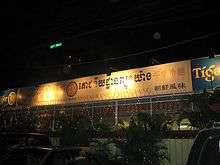Pyongyang (restaurant chain)

Pyongyang is a chain of 130 restaurants named after the capital of North Korea in a dozen countries around the world.[1] The restaurants are owned and operated by the Haedanghwa Group, an organisation of the government of North Korea.[2]
Locations
Pyongyang restaurants are found mainly in China near the North Korean border and also Beijing and Shanghai, but in the 2000s the chain has been expanding into South East Asian cities including Bangkok, Phnom Penh,[3] Siem Reap, Ho Chi Minh City, Hanoi, Da Nang, Vientiane, Dhaka,[4] Jakarta[5] and Kuala Lumpur.[6] There is also one restaurant in Ulaanbaatar, Mongolia and one in Kathmandu, Nepal. The restaurants initially catered to the many South Korean businessmen in South East Asia, and have now become popular with curious tourists.[7] The first Western outpost of the restaurant chain was opened in Amsterdam in 2012, in the residential neighborhood of Osdorp, along with Dutch co-owners.[8] The menu and policies of this restaurant differed from its Asian counterparts, serving no dog meat or ginseng wine. However, in September, 2012, amid mutual accusations between the Korean staff and the Dutch partner, the restaurant closed.[9] It reopened in December 2013 under the name Haedanghwa in a new location,[2] which closed a year later. The restaurant's locations in Bangkok were temporarily shut down, but were re-opened again in 2015. Similarly, their branches in Pattaya were closed down. It was reported that a new branch was set to open in Scotland, in line with Kim Jong Un's interest in the country after its 2014 independence referendum, although this has been denied by North Korean officials.[10][11] According to Japan's Yomiuri Shimbun newspaper there are some 100 North Korean restaurants in China alone.[12]
Service

The restaurants serve Korean food, including kimchi dishes, Pyongyang "cold noodle", barbecued cuttlefish and dog meat soup.[6] Patrons may also buy North Korean products such as ginseng wine and an unlabelled aphrodisiac claimed to be made from bears.[6] The prices are relatively high and in US dollars.[6]
The staff are attractive, young Korean women in traditional Chosŏn-ot dress, who also perform karaoke as well as song and dance routines in the style of the North Korean Mass Games for the customers.[6][13] Staff from North Korea typically work on 3 year contracts, and are often highly trained graduates of arts colleges.[3] Photography is generally not permitted inside.[3][6]
Operation
According to Swedish journalist Bertil Lintner, the restaurants are one of several overseas business ventures of Room 39, a North Korean government organization dedicated to acquiring and laundering foreign currency for the North Korean leadership.[6]
North Korean defectors report that the restaurants are run by local middlemen who are required to pay between US$10,000 and US$30,000 each year to the North Korean government.[6][13] The North Korean staff, who live on the restaurant premises,[3] are said to be thoroughly screened for political loyalty and to be closely watched by on-site North Korean security agents.[6] In the 2000s, according to Daily NK, several attempted escapes by waitresses in China led to the closure of several restaurants and the repatriation of their staff.[14][15] In 2016, South Korea announced that 13 restaurant workers had defected from a Pyongyang restaurant chain abroad.[16][17]
See also
- Branches outside North Korea of Okryugwan or Okryu Restaurant that is a restaurant in Pyongyang, North Korea, founded in 1960.
References
- ↑ Choe, Sang-Hun (13 April 2016). "North Korea Threatens South Korea over 13 Defectors". New York Times. Retrieved 13 April 2016.
- 1 2 "DPRK Restaurant in Amsterdam Reopened Under New Ownership". North Korea Leadership Watch. Retrieved 30 August 2014.
- 1 2 3 4 Ed Butler (7 June 2014). "Mort Pour La France". From Our Own Correspondent. 22:25s minutes in. BBC. Radio 4. Retrieved 7 June 2014.
- ↑ Mitra, Devirupa. "Dining with Dear Leader in Dhaka". The Sunday Standard. New Indian Express. Retrieved 20 May 2015.
- ↑ Tash Roslin (May 6, 2010). "North Korea's Hidden Menu". Jakarta Globe. Retrieved March 10, 2014.
- 1 2 3 4 5 6 7 8 9 Strangio, Sebastian (22 March 2010). "Kingdom Kim's Culinary Outposts: Inside the bizarre world of Asia's North Korean restaurant chain.". Slate. Retrieved 23 March 2010.
- ↑ "Pyongyang Restaurants Extending Reach in Southeast Asian Cities (public domain text as cited)". Voice of America, Khmer-English. Retrieved January 13, 2012.
- ↑ Pyongyang Restaurant, [Archived link]
- ↑ "Noord-Koreaans restaurant al weer dicht". AT5 Nieuws. September 5, 2012. Retrieved September 6, 2012.
- ↑ "Kim Jong-un 'set to open a new restaurant in SCOTLAND'".
- ↑ "North Korea denies reports Kim Jong-un is to open state-backed restaurant in Scotland". The Independent. Retrieved 12 May 2015.
- ↑ "NK eateries in Liaoning ban S.Korean customers - Global Times". Globaltimes.cn. 2016-06-17. Retrieved 2016-09-13.
- 1 2 Kim, Min Se (19 June 2007). "North Korean Restaurants in China Send $10,000–30,000 Annually Back to Its Native Country". Daily NK. Retrieved 23 March 2010.
- ↑ Kwon, Jeong Hyun (21 March 2007). "North Korean Restaurant in China Shuts Down as Receptionist Escapes". Daily NK. Retrieved 23 March 2010.
- ↑ Kim, Yong Hun (15 December 2006). "Waitresses Flee North Korean Restaurants in Qingdao China". Daily NK. Retrieved 23 March 2010.
- ↑ "North Korean staff at restaurant in third country defect to South". Reuters India. 8 April 2016. Retrieved 2016-04-08.
- ↑ "North Korean restaurant defectors 'were in China and left legally'". BBC News. 12 April 2016. Retrieved 12 April 2016.